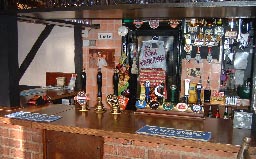
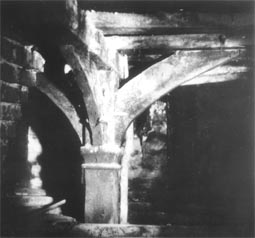
In 1889 ‘The Queen’s Head Inn, situated in Queen
Street’ was put up for sale and the sale poster read as follows:
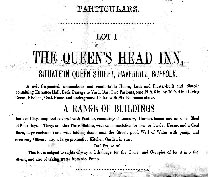
‘A well frequented, commodious and comfortable House, Lath and
Plaster-built and Slated; containing Entrance Hall, Back Passage to Yard,
Two Parlours, (one 17ft.6in. by 16ft.4in.), Living Room, Kitchen, Coal-House
and underground Cellar, with Six Bedrooms above’.
‘The Sale Notice goes on to say:
A Range of Buildings built of Clay-lump and covered with Pantiles,
consisting of Laundry, Harness-house and an open Shed of Four Bays. There
are also Three Stables, with accommodation for Ten or Twelve Horses, and
a Coal Barn,.
In 1889 the Queen’s Head was not purchased by another brewery (who would have presumably removed the ‘Ward’s’ window), but was sold to a William Farrants for the grand sum of £2,100. Thus, the inn reverted to being a ‘free house’, a status that it seems to have maintained for well over one hundred years.
The range of buildings described above does not include reference to a brew-house – presumably because brewing had ceased on the site, but an extant, pantiled, building adjacent to, and at the rear, of the pub, still bears a louvred vent in the roof typical of a small brewery.
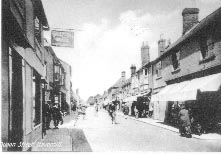
Queens Street in the early 20s
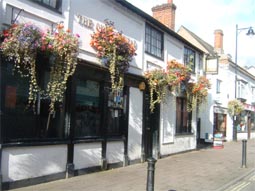
THE QUEENS HEAD:
A Life Feature by Ian Hornsey (Dec 2007)
The Queen’s Head, in Haverhill’s Queen Street
is one of the oldest buildings in town, and probably dates from the 14th
century.
It survived the great fire of 1667, and another one in 1766, and has emerged
relatively unscathed from any number of floods, the most recent being
those of June 1903 and June 1958.
The precise age of this timber-framed building is not known, but it is
certainly of mediaeval origin, and may well have started life as the residence
of a wealthy merchant. It is recorded as an inn by the mid-15th century,
when the Saturday market was very active, and it was one of the “many
inns that abut upon the Highway leading from the market to Cambridge and
other Townes”. The land belonging to these roadside inns was known
as “ye Market Meadowes”. Over the years, the inn has had its
share of characters, having at various times been notable as a haven for
disreputable clerics, as a solace for ‘tired and emotional’
coach drivers, and in more recent times, the
unofficial HQ of the rugby club!
In more recent times the Queens Head was sold by auction
at the ‘Lion Hotel’, Cambridge, on Monday December 20th 1926.
The last freehold licensee was the redoubtable Graham Morse, who sold
the property to the pub company Innspired. In 2004, Innspired were purchased
by another ‘pubco’, Punch Taverns, who in April this year
entered the ‘FTSE 100’, the group of Britain’s biggest
financial players. The present landlady is Diana
Bruton, who has been there since
December 2003.
The dates of many surviving buildings can be roughly estimated
by the nature of the trusses used to frame the roof, and inside the roof
of the Queen’s Head is a give-away artefact, the ‘crown post’
shown in the photo.
The ‘Queen’s’ was owned at one time by
the brewery in Camps Road, which was started by the Boreham family in
1809.
The brewery passed into the hands of one William Ward somewhere between
1874 and 1885, by which time it had become known as the ‘Haverhill
Brewery’. The ownership of the Queen’s Head by Ward’s
of Haverhill was evidenced until recently by a splendid window panel at
the side of the pub, which proudly proclaimed ‘W.Wards & Son,
brewers’. Sadly, this unique part of local history was vandalised
in 1996, and left in an irreparable condition.
The Haverhill Wards must have been successful at one time because their
trading area included Castle Hedingham, Saffron Walden, Fulbourn and Swaffham
Bulbeck. But things were evidently not going completely to plan, because
Ward & Son decided to sell off their Queen Street premises in 1889,
presumably to alleviate their financial situation.
In fact the fortunes of the Wards Brewery went from bad to worse and on Tuesday, 23rd January, 1894, Ward & Son’s Brewery was put up for sale at the Mason’s Hall, London, EC, The maltings were across the Camps Road from the brewery, and are now the site of the Health Centre.
The brewery and estate (minus the Queen’s Head) was purchased by a Frederick Charles Christmas, and it remained in his family before being sold to Greene, King & Co. in 1918.
Crown post roofs were first built in southern England in the mid-14th century, and were a feature of grand houses, known as ‘hall houses’. The crown post created a stable roof by providing bracing in several directions. The crown post, itself, stood centrally on a tie beam, and was connected to a longitudinally-running collar beam, or purlin (see diagram). The purlin, in turn, supported the collars which joint the pairs of rafters. This form of roof construction remained popular until about 1550.
